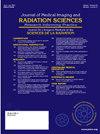放射治疗科自动轮廓系统的实施
IF 2
Q3 RADIOLOGY, NUCLEAR MEDICINE & MEDICAL IMAGING
Journal of Medical Imaging and Radiation Sciences
Pub Date : 2025-05-01
DOI:10.1016/j.jmir.2025.101947
引用次数: 0
摘要
目的/目的晚期姑息治疗计划和住院病人的明显增加增加了计划的复杂性,需要在更短的时间内提供更多的轮廓以适应紧急病例。为了满足日益增长的对复杂姑息治疗病例的需求并减少减速,安装了自动轮廓(AC)系统并将其集成到规划工作流程中。目标是通过CT仿真人员审查、编辑和批准自动生成的轮廓,而不是手动生成轮廓,从而缩短轮廓完成时间。方法/流程在2024年选择交流系统供应商和实施之前,初步研究评估了准备情况、易用性和最终产品结果。通过使用“一键式”基于云的解决方案,只需一天的供应商安装就可以实现顺利的集成。培训计划由物理学推动,并提供给CT模拟工作人员,定期进行常规随访,讨论工作流程的变化。这些变化是根据放射肿瘤学家、剂量学和物理学家的反馈而制定的。在完成规划的ct扫描后,数据集通过DICOM导出手动发送到AC系统。然后,在计划创建和发布之前,由AC系统生成的轮廓由CT模拟人员手动审查和编辑。结果或益处/挑战初步调查证明,交流系统和放射治疗师生成的轮廓的准确性和完整性是相当的。此外,CT模拟和剂量测定工作人员的定性反馈表明,生产力和工作流程得到了改善。AC系统的过度轮廓导致过多的轮廓需要在发布前手动删除。为了解决这个问题,开发了一个批量删除工具,并在系统部署的早期实现了该工具。另一个挑战是AC系统在处理近距离治疗患者方面的缺点。虽然这个问题仍未解决,但我们正在与供应商合作,努力改善AC系统在这一患者群体中的使用。AC系统使用标准化模板来应用适用的轮廓,最初的挑战确实是由于CT模拟人员和放射肿瘤学家应用了错误的模板。随着时间的推移,这种出现的频率随着常规随访和额外的培训而减少,其中包括在绘制的轮廓模板中进一步增加透明度。结论/影响在实施交流系统的早期就解决了挑战,使全体员工都能接受。该系统现在用于自动生成规划CT扫描的轮廓,包括所有治疗地点和紧急代码。AC系统已被证明对高级姑息治疗计划(VMAT)最有效,在缩短的时间内实现更快的周转,同时管理增加的轮廓需求。空调系统的使用是所有技术现场小组的一个常设项目,以审查和优化其有效性,以应对可能出现的任何现场特定问题。本文章由计算机程序翻译,如有差异,请以英文原文为准。
Implementation of an Automatic Contouring System within a Radiation Therapy Department
Purpose/Aim
The observable increase in advanced palliative treatment plans and retreat patients adds to planning complexity, necessitating more contours within shorter timelines to accommodate urgent cases. To support the increased demand for complex palliative treatment cases and reduce slowdowns, an automatic contouring (AC) system was installed and integrated into the planning workflow. The goal was to improve contouring completion time by having CT simulation staff review, edit and approve automatically generated contours rather than generate them manually.
Methods/Process
An initial study assessed readiness, ease of use and end product outcomes prior to selecting an AC system vendor and implementation in 2024. By utilizing a “one-click,” cloud based solution, a smooth integration was achieved requiring only a single day of vendor installation. A training program was facilitated by physics and delivered to CT simulation staff with regular, routine follow-up where changes to the workflow were discussed. These changes were developed based on feedback from Radiation Oncologists, dosimetry and physics. After completion of a planning CT-scan, the dataset is manually sent to the AC system via a DICOM export. Contours generated by the AC system are then manually reviewed and edited by CT simulation staff, prior to plan creation and publishing.
Results or Benefits/Challenges
Initial investigations proved that contour accuracy and integrity between the AC system and those generated by radiation therapists were comparable. Furthermore, qualitative feedback from CT simulation and dosimetry staff indicates an increase in productivity and workflow improvement. Over-contouring by the AC system resulted in excessive contours requiring manual deletion prior to publishing. To address this, a batch deletion tool was developed and implemented early in the system's deployment. Another challenge was the AC system's shortcomings in handling brachytherapy patients. While this issue remains unresolved, efforts are ongoing in collaboration with the vendor to improve the AC system's use for this patient population. The AC system utilizes standardized templates to apply applicable contours, initial challenges did arise with wrong templates being applied by both CT simulation staff and the Radiation Oncologist. The frequency of this arising diminished over time with routine follow-up and additional training which included further transparency in mapped contour templates.
Conclusions/Impact
Addressing the challenges early on in the implementation of the AC system allowed for overall staff acceptance. The system is now used to automatically generate contours for planning CT scans that includes all treatment sites and urgency codes. The AC system has proven most effective for advanced palliative plans (VMAT), enabling quicker turnarounds on condensed timelines, while managing the increased contouring demands. The use of the AC system is a standing item at all technical site groups to review and optimize its effectiveness for any site specific issues that may arise.
求助全文
通过发布文献求助,成功后即可免费获取论文全文。
去求助
来源期刊

Journal of Medical Imaging and Radiation Sciences
RADIOLOGY, NUCLEAR MEDICINE & MEDICAL IMAGING-
CiteScore
2.30
自引率
11.10%
发文量
231
审稿时长
53 days
期刊介绍:
Journal of Medical Imaging and Radiation Sciences is the official peer-reviewed journal of the Canadian Association of Medical Radiation Technologists. This journal is published four times a year and is circulated to approximately 11,000 medical radiation technologists, libraries and radiology departments throughout Canada, the United States and overseas. The Journal publishes articles on recent research, new technology and techniques, professional practices, technologists viewpoints as well as relevant book reviews.
 求助内容:
求助内容: 应助结果提醒方式:
应助结果提醒方式:


